Characterizing Teacher Knowledge Tests and Their Use in the Mathematics Education Literature
We present findings from an analysis of tests of teacher mathematical knowledge identified over a 20-year period of mathematics education literature. This analysis is part of a larger project aimed at developing a repository of instruments and their associated validity evidence for use in mathematics education. We report on how these tests are discussed in the literature, with a focus on validity arguments and evidence. A key finding is that these tests are often presented in ways that do not support their use by the mathematics education community.
We present findings from an analysis of tests of teacher mathematical knowledge identified over a 20-year period of mathematics education literature, and report on how these tests are discussed in the literature, with a focus on validity arguments and evidence.
